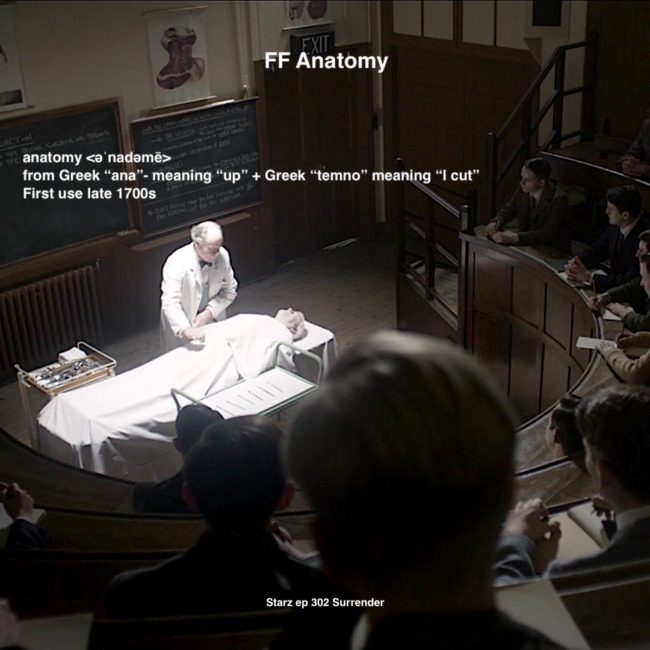
Anatomy Def: Ha, ha – anatomy defines anatomy! No, just joshing. Anatomy is the science of the body (human and other organisms) and its parts.
Outlander Def: Claire’s first day in Dr. Simms’ anatomy theater as the only female first year medical student. Don’t touch my blade, young lady! <G> Grateful Joe Abernathy was at her side and she by his.
Learn the history of this topic in Anatomy Lesson #34, The Amazing saga of Human Anatomy.
Human Anatomy is the oldest of the medical sciences. The word derives from the Greek ana-, meaning up combined with temnō, meaning I cut. It doesn’t take rocket science to recognize this term infers the use of dissection to discern an organism’s design.
Fun Fact: This is important. Do you ken how to pronounce the word, dissection? It is pronounced dis-section not di-ssection. Thus, we dis-sect an organism but we bi-sect a line. Got it? Yay, students!
Anatomy covers the structure of cells, tissues, organs, and organ systems throughout all stages of life. The anatomist is concerned with name, shape, size, position, texture, relationship, blood supply, and innervation of such structures. Classically, physiologists study function and biochemists follow processes, although nowadays, these distinctions tend to blur.
The roots of human anatomy arguably began with the Ancient Egyptians (2,600 BCE), a culture which believed a soul could retrieve its mummified body before journeying to the underworld. These embalmers understood some anatomical regions quite well. But, if we include animal anatomy, first prize goes to creators of Australian Aboriginal rock art, some of which date to 40,000 years ago!
Human anatomy with dissection has been the foundation of western medicine for the last several hundred years. Why? Well, if your beloved computer goes haywire, you don’t want joe blow tinkering with it, do you? Likewise, who places their body in the hands of a practitioner who knows little about its design? Nope!
Early western medical schools used three individuals to present a dissection. A lecturer stood on a raised dais and read from an ancient anatomical text (Galen). A barber surgeon performed the dissection. An individual wearing a black hat pointed to the structures using a baton. Over the years, barber surgeon and black hat fused into a single position, the Demonstrator of Anatomy, a position I held at my institution for almost two decades.
Then, a huge leap in anatomical knowledge occurred in the 16th century, due largely to the genius of Flemish physician and anatomist, Andreas Vesalius (1514-1564), Father of Modern Anatomy. Andreas championed dissection coupled with direct observation, thereby dispelling wrongful ideas that had endured for over 1400 years!
Following the work of Vesalius, human anatomy enjoyed a burst of anatomical discovery and illustration! Today’s anatomical “bible” is, of course, Gray’s Anatomy. My own edition weighs in at 10 pounds, appears in size 8 font, and boasts 1500+ pages. And, it still doesn’t cover the entire breadth and depth of human anatomy!
Read about Claire’s commitment to anatomy, medicine, and surgery in Voyager book. From the “pen” of Herself:
I picked up his right hand and transferred it to my own knee. He let it lie there, warm, heavy and inert, and didn’t object as I felt each finger, pulling gently to stretch the tendons and twisting to see the range of motion in the joints.
“My first orthopedic surgery, that was,” I said wryly.
“Have ye done a great many things like that since?” he asked curiously, looking down at me.
“Yes, a few. I’m a surgeon—but it doesn’t mean then what it means now,” I added hastily. “Surgeons in my time don’t pull teeth and let blood. They’re more like what’s meant now by the word ‘physician’—a doctor with training in all the fields of medicine, but with a specialty.”
“Special, are ye? Well, ye’ve always been that,” he said, grinning. The crippled fingers slid into my palm and his thumb stroked my knuckles. “What is it a surgeon does that’s special, then?”
I frowned, trying to think of the right phrasing. “Well, as best I can put it—a surgeon tries to effect healing … by means of a knife.”
His long mouth curled upward at the notion.
“A nice contradiction, that; but it suits ye, Sassenach.”
See Claire’s anatomy course in Starz ep 302, Surrender. Six scalpels lay before Dr. Simms. Where are the scissors? But the truth is, a scalpel is useful for skin incisions but it is then laid aside and replaced with the finest dissection tool of all: a pair of long-bladed scissors!
The deeply grateful
Outlander Anatomist
Postscriptum: I have had the privilege of teaching dissection using more than 500 donor bodies. I thank them and their families for the privilege of learning from their temples of flesh. Dissecting the human body is an honor that has changed me, forever.
Photo Credits: Starz

